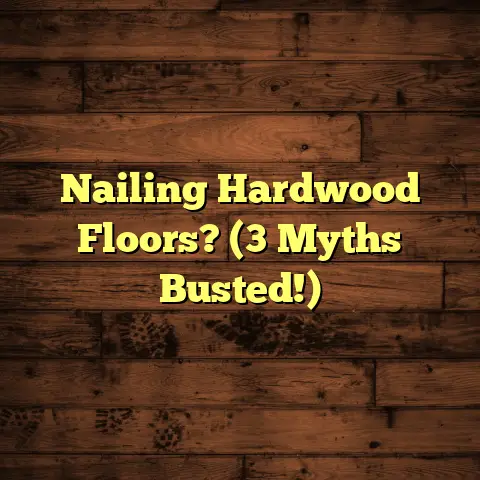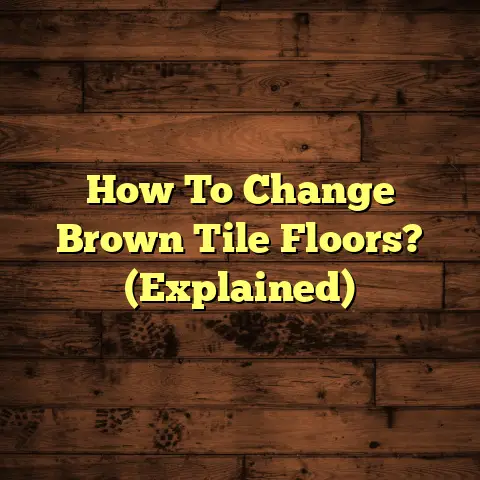Hardwood Cracking? (10 Causes Exposed!)
Let’s face it, hardwood flooring is often seen as the
pinnacle of home aesthetics.
It’s durable, gorgeous, and
adds a real touch of class to any space.
That’s why it
comes with a premium price tag.
But what if that beautiful investment starts to crack?
Suddenly, the dream turns into a potential nightmare.
Cracking can undermine the entire value proposition of
hardwood.
The good news is, understanding the causes of
cracking is the first step to preventing it.
That’s where I come in!
I’m here to share my experience
and help you keep your hardwood floors looking their best
without breaking the bank.
We will look at the causes and how to prevent them.
So, let’s dive in!
Section 1: Understanding Hardwood Flooring
So, what exactly makes hardwood flooring so special?
Well, for starters, it’s real wood!
We’re talking oak,
maple, cherry, walnut – the list goes on.
Each species has its own unique grain pattern, color,
and hardness.
That’s why there are so many different
looks you can achieve with hardwood.
Homeowners choose hardwood for its durability, timeless
beauty, and the value it adds to their homes.
Plus,
it’s a natural material, which appeals to those of us
who are environmentally conscious.
But let’s be real, the installation process is a big
part of the cost.
Proper installation is crucial for
the longevity of your floors.
And that’s why it’s so important to be aware of potential
issues like cracking.
Prevention is always better (and
cheaper!) than cure.
Section 2: Cause 1 – Dry Air Conditions
Ever notice how your skin gets dry in the winter?
Well, hardwood floors react to dry air in a similar way.
Wood is a hygroscopic material, meaning it absorbs and
releases moisture from the surrounding air.
When the air is dry, the wood loses moisture and shrinks.
This shrinkage can create stress within the wood, leading
to cracks.
This is especially common in climates with cold winters where heating systems are constantly running.
Think about it: your furnace is sucking moisture out of the air, creating a desert-like environment inside your home.
The cost of neglecting this issue can be significant.
I’ve seen floors that have completely split apart due to
extreme dryness.
To combat this, invest in a good humidifier.
Aim for a
relative humidity level of 30-50% in your home.
You can also use a hygrometer to monitor the humidity levels.
Section 3: Cause 2 – Improper Installation
Okay, this is a big one.
I can’t stress enough how
important proper installation is.
I’ve seen so many beautiful hardwood floors ruined by
sloppy installation.
One of the most common mistakes
is inadequate acclimatization.
Acclimatization is the process of allowing the wood to adjust to the temperature and humidity conditions of your home before installation.
If you skip this step, the wood will continue to expand or contract after it’s installed, leading to gaps, warping, and yes, cracking.
Another common mistake is poor subfloor preparation.
The subfloor needs to be level, clean, and dry.
If it’s not, the hardwood will be unevenly supported, which can cause stress and cracking.
Incorrect fastening techniques can also lead to problems.
Using the wrong type of nails or screws, or spacing them
incorrectly, can weaken the floor and make it more
susceptible to cracking.
The cost of correcting these mistakes can be astronomical.
You might have to tear up the entire floor and start over.
So, do yourself a favor and hire a qualified, experienced
installer.
It’s worth the investment.
Section 4: Cause 3 – Moisture Damage
Moisture is hardwood’s worst enemy. I cannot overstate this.
Whether it’s from a leaky pipe, a spilled glass of water, or even just high humidity, moisture can wreak havoc on your floors.
When hardwood absorbs moisture, it swells.
And when it
dries out, it shrinks.
This constant expansion and
contraction can create stress within the wood, leading to cracks.
Water damage is a common issue.
According to the EPA,
about 13.7% of all homes have leaks that waste 90 gallons
or more per day.
Addressing moisture issues promptly is critical.
If you
notice a leak, fix it immediately.
Clean up spills right away.
And consider using mats and rugs in high-traffic areas to
protect your floors from moisture.
Neglecting water damage can lead to costly repairs, including replacing entire sections of your floor.
Section 5: Cause 4 – Temperature Fluctuations
Just like humidity, temperature can also affect hardwood floors.
Extreme temperature changes can cause the wood to expand and contract, leading to stress and cracking.
For example, if you turn off your heating system while you’re away on vacation in the winter, the temperature in your home can drop dramatically.
This can cause the wood to shrink rapidly, leading to cracks.
Conversely, if you crank up the heat too high, the wood
can dry out and crack.
Maintaining a consistent temperature in your home is key to preventing this type of damage.
Aim for a temperature range of 60-80°F.
You can also
use a programmable thermostat to automatically adjust the
temperature while you’re away.
The cost of neglecting temperature control can be significant.
I’ve seen floors that have buckled and cracked due to
extreme temperature fluctuations.
Section 6: Cause 5 – Lack of Maintenance
Let’s be honest, nobody loves cleaning.
But regular
maintenance is essential for keeping your hardwood floors
in good condition.
Dust, dirt, and grime can accumulate on the surface of your floors, scratching the finish and dulling the wood.
Over time, these scratches can weaken the wood and make it more susceptible to cracking.
Regular cleaning is essential.
Sweep or vacuum your floors
regularly to remove dust and dirt.
Use a damp mop with a
pH-neutral cleaner to clean the surface.
Avoid using harsh chemicals or abrasive cleaners, as they can damage the finish.
Refinishing is also important.
Over time, the finish on
your floors will wear down, leaving the wood exposed to moisture
and damage.
Refinishing involves sanding down the old finish and applying
a new coat.
This will protect the wood and keep it looking
its best.
The cost of neglecting regular maintenance can be high.
I’ve seen floors that have been so badly damaged by dirt
and grime that they had to be completely replaced.
Section 7: Cause 6 – Heavy Furniture and Equipment
Think about that massive bookshelf you just bought. Or that antique piano.
Heavy furniture and equipment can put a lot of stress on your hardwood floors.
The weight can compress the wood, leading to dents and cracks.
This is especially true if the weight is concentrated in
a small area.
To prevent this, use furniture pads under the legs of heavy
items.
This will distribute the weight more evenly and
protect the floor.
Avoid dragging heavy furniture across the floor. Lift it instead, or use furniture sliders.
The financial impact of replacing cracked boards versus
preventative measures is significant.
Furniture pads are cheap.
Replacing damaged flooring is not.
Section 8: Cause 7 – Inadequate Acclimatization (Again!)
I know I mentioned this earlier, but it’s so important that it bears repeating.
Inadequate acclimatization is a major cause of hardwood cracking. I cannot stress this enough.
Before you install your hardwood floors, you need to allow the wood to adjust to the temperature and humidity conditions of your home.
This process can take several days or even weeks, depending on the type of wood and the climate.
The science behind wood acclimatization is simple: wood expands and contracts in response to changes in humidity.
If you install the wood before it has had a chance to acclimatize, it will continue to expand or contract after it’s installed, leading to gaps, warping, and cracking.
The potential costs involved in correcting mistakes made
during installation are significant.
You might have to
tear up the entire floor and start over.
So, be patient and allow the wood to acclimatize properly. It’s worth the wait.
Section 9: Cause 8 – Natural Wood Characteristics
Sometimes, cracking is simply due to the natural characteristics of the wood itself.
Different wood species have different levels of stability.
Some species are more prone to cracking than others.
For example, hickory is a very hard and durable wood, but
it’s also relatively unstable.
It’s more likely to crack
than a more stable wood like oak.
The way the wood is cut can also affect its stability.
Quarter-sawn wood is more stable than plain-sawn wood.
If you’re concerned about cracking, choose a more stable wood species and consider using quarter-sawn wood.
Impact on investment?
Choosing a more stable wood might
cost a bit more upfront, but it can save you money in the
long run by preventing cracking.
Section 10: Cause 9 – Age of the Flooring
Like anything else, hardwood floors age over time.
The finish can wear down, the wood can become brittle, and the floor can become more susceptible to cracking.
This is especially true for older floors that have not been properly maintained.
Regular refinishing can help to extend the life of your
floors.
But eventually, all hardwood floors will need to
be replaced.
The financial implications of maintaining older floors versus investing in new installations can be complex.
Refinishing can be a cost-effective way to extend the life of your floors, but at some point, it’s simply more economical to replace them.
Section 11: Cause 10 – Environmental Factors
Finally, let’s talk about environmental factors.
Humidity, local climate, and even seasonal changes can all impact hardwood flooring.
In areas with high humidity, the wood will absorb more moisture, leading to swelling and potential cracking.
In dry climates, the wood will lose moisture, leading to shrinkage and cracking.
Even seasonal changes can affect your floors.
As the
seasons change, the temperature and humidity levels in
your home will fluctuate, which can cause the wood to expand
and contract.
Managing these factors can lead to unexpected costs if not properly managed.
For example, you might need to invest in a humidifier or dehumidifier to control the humidity levels in your home.
Conclusion
So, there you have it: ten causes of hardwood cracking.
Understanding these causes is essential for protecting your investment in hardwood flooring.
Remember, prevention is always better (and cheaper!) than cure.
By taking steps to prevent cracking, you can keep your
hardwood floors looking their best for years to come.
Investing in quality flooring is a big decision.
Protect that investment by being proactive and informed.
Thanks for reading, and happy flooring!





